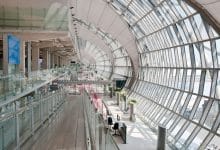AirAsia: Bangkok to rival Dubai as aviation hub

In a meeting with Prime Minister Srettha Thavisin, AirAsia unveiled ambitious plans to transform Bangkok into the aviation hub of Southeast Asia, aiming to mirror the success of Dubai.
The low-cost carrier is urging the Thai government to slash the excise tax on jet fuel, a move it believes will further propel the country’s tourism industry.
AirAsia’s top brass, led by founder and CEO Tony Fernandes, engaged in their inaugural discussion with PM Srettha yesterday, January 10. The aviation group is set to present a series of proposals this week, seeking governmental support to boost Thailand’s tourism sector.
Key among these requests is a substantial 40% reduction in the excise tax on jet fuel for domestic routes, an anomaly that sets Thailand apart from regional counterparts like Malaysia and Indonesia.
Fernandes, expressing his commitment to the growth of tourism, revealed AirAsia’s firm order of 421 Airbus aircraft, with 75% of the fleet already financed. He envisioned the city’s airport as a regional hub connecting 700 million passengers to Europe, Africa, and the Middle East.
“It’s time for Bangkok to be the Dubai of ASEAN.”
Calling for improvements, the AirAsia CEO urged Airports of Thailand (AOT) to enhance facilities and expand capacity or designate a terminal for low-cost carriers. This, he argues, would facilitate lower passenger fees and enhance the overall travel experience.
The AirAsia Group’s consolidation strategy includes the imminent merger of its short-haul service, AirAsia, and long-haul AirAsia X. Fernandes expects this union to be completed by the end of the year, beginning with the Malaysian units. The merger aims to alleviate congestion at various airports, providing flexibility to switch between single-aisle and wide-body jets based on demand, reported Bangkok Post.
New jets
Tassapon Bijleveld, Executive Chairman of Asia Aviation, shared insights into the aircraft order, revealing that Thai AirAsia would receive 100 to 150 of the 421 ordered jets. Notably, the order includes A321XLR jets, equipped for extended 12-hour flights, facilitating AirAsia X’s plans to reach European cities and even Almaty in Kazakhstan.
Despite facing maintenance challenges with its current fleet, Thai AirAsia X is optimistic about expanding its active aircraft count. Anticipating an exit from its rehabilitation plan by next year, the airline is set to negotiate a significant reduction in debts, paving the way for a seamless merger into a single airline.
“After merging into a single airline, we will continue to use two airports in Bangkok as our hubs.”
Latest Thailand News
Follow The Thaiger on Google News:


























